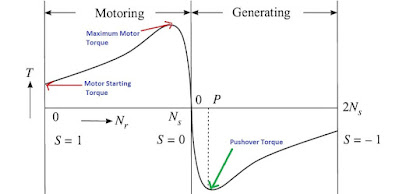An induction generator is also called an asynchronous generator. An induction machine can work as a generator. For working as a generator initially, the three-phase induction motor is started as a motor.
During motoring operation, it draws reactive volt-amperes from the main supply then the speed of the machine is increased above the synchronous speed of the rotating magnetic field of the stator using an external prime mover in the same direction of the rotor and rotating magnetic field produced by stator windings.
The below diagram shows the complete torque-speed characteristic of 3 phase induction machine for all speed ranges.

As the speed of the rotor increases above synchronous speed Ns, the machine will start operating as an induction generator and will produce a generating torque.
This generating torque produced by the machine is opposite to the rotation of the rotor or opposite to the rotating field produced by the rotor.
In this case, the slip of the motor becomes negative and it starts delivering electrical power to the supply mains.
If the shaft load has been replaced by a resistor of the value given by
Rmech= R(1-s)/ s
In this case, slip s is negative, and therefore the load resistance Rmech is also negative this shows that load resistance no longer absorbs power but acts as a source of power to source.
The output of the generator depends upon the magnitude of the negative slip or on the speed of the rotor above the synchronous speed driven by the prime mover in the same direction of the rotor or rotating field of the stator.
From the torque-speed characteristic, there is a maximum possible induced torque in the generating mode called as pushover torque of the generator. If the prime mover applies a torque greater than the pushover torque of the generator, the generator will Overspeed.
The induction generator is not a self-excited generator it requires a supply of excitation current to the stator from the polyphase source at all-time at rated voltage and frequency and driven at the above synchronous speed set by the supply frequency.
Advantages of Induction generator
- The induction generator required less maintenance
- It has a small size per KW output power
- It does not require to be synchronized with the supply line as the synchronous generator.
- The induction generator can run parallel without hunting
- It has a self-protective feature, if a short circuit fault occurs on its terminal the excitation fails and the machine will stop generating.
Limitations
An induction generator can not generate reactive power instead it requires reactive volt-amperes from the supply to furnish its excitation.